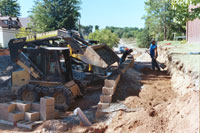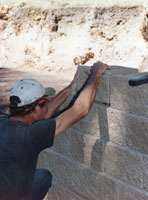 Segmental retaining walls are constructed by laying several courses and sometimes geogrid fabrics are used to anchor the wall back into the earth behind the wall.
Segmental retaining walls are constructed by laying several courses and sometimes geogrid fabrics are used to anchor the wall back into the earth behind the wall.
Segmental retaining walls (SRWs) are popular for use as transportation structures, especially bridge abutments, and also for residential landscaping applications. They accommodate grade changes effectively, can be laid in any combination of curved and straight wall sections, and look good. The walls may be vertical or slightly inclined toward the side retaining earth.
 Placing a segmental retaining wall unit with a split-face finish. Block is held in place by gravity/friction and with pins between courses.
Placing a segmental retaining wall unit with a split-face finish. Block is held in place by gravity/friction and with pins between courses.
Segmental retaining walls are single wythe walls laid without mortar. Units are designed to interlock between courses or to use mechanical devices like connecting pins to resist lateral soil pressure. Walls typically range in height from 8 inches to 20 feet. For added stability on taller walls, geosynthetic fabric can be laid between various courses and embedded in the soil as an anchor.
Segmental retaining wall units are often finished with a decorative color and/or texture. Units are manufactured to conform to ASTM C1372 Standard Specification for Dry-Cast Segmental Retaining Wall Units. The standard includes notes to the purchaser about specifying optional characteristics such as weight classification, high compressive strength, and surface texture, finish, or color where desired.
For more information, see the National Concrete Masonry Association’s TEK sheets on segmented retaining walls.